
Product
Introducing Webhook Events for Pull Request Scans
Add real-time Socket webhook events to your workflows to automatically receive pull request scan results and security alerts in real time.
@creately/tinymce
Advanced tools
Install Node.js on your system. Clone this repository on your system
$ git clone https://github.com/tinymce/tinymce.git
Open a console and go to the project directory.
$ cd tinymce/
Install grunt command line tool globally.
$ npm i -g grunt-cli
Install all package dependencies.
$ npm install
Now, build TinyMCE by using grunt.
$ grunt
grunt
Lints, compiles, minifies and creates release packages for TinyMCE. This will produce the production ready packages.
grunt start
Starts a webpack-dev-server that compiles the core, themes, plugins and all demos. Go to localhost:3000 for a list of links to all the demo pages.
grunt dev
Runs tsc, webpack and less. This will only produce the bare essentials for a development build and is a lot faster.
grunt test
Runs all tests on PhantomJS.
grunt bedrock-manual
Runs all tests manually in a browser.
grunt bedrock-auto:<browser>
Runs all tests through selenium browsers supported are chrome, firefox, ie, MicrosoftEdge, chrome-headless and phantomjs.
grunt webpack:core
Builds the demo js files for the core part of tinymce this is required to get the core demos working.
grunt webpack:plugins
Builds the demo js files for the plugins part of tinymce this is required to get the plugins demos working.
grunt webpack:themes
Builds the demo js files for the themes part of tinymce this is required to get the themes demos working.
grunt webpack:<name>-plugin
Builds the demo js files for the specific plugin.
grunt webpack:<name>-theme
Builds the demo js files for the specific theme.
grunt --help
Displays the various build tasks.
grunt bundle --themes=modern --plugins=table,paste
Minifies the core, adds the modern theme and adds the table and paste plugin into tinymce.min.js.
TinyMCE is an open source software project and we encourage developers to contribute patches and code to be included in the main package of TinyMCE.
Basic Rules
These basic rules ensures that the contributed code remains open source and under the LGPL license.
How to Contribute to the Code
The TinyMCE source code is hosted on Github. Through Github you can submit pull requests and log new bugs and feature requests.
When you submit a pull request, you will get a notice about signing the Contributors License Agreement (CLA). You should have a valid email address on your GitHub account, and you will be sent a key to verify your identity and digitally sign the agreement.
After you signed your pull request will automatically be ready for review & merge.
How to Contribute to the Docs
Docs are hosted on Github in the tinymce-docs repo.
How to contribute to the docs, including a style guide, can be found on the TinyMCE website.
FAQs
TinyMCE rich text editor
We found that @creately/tinymce demonstrated a not healthy version release cadence and project activity because the last version was released a year ago. It has 3 open source maintainers collaborating on the project.
Did you know?

Socket for GitHub automatically highlights issues in each pull request and monitors the health of all your open source dependencies. Discover the contents of your packages and block harmful activity before you install or update your dependencies.

Product
Add real-time Socket webhook events to your workflows to automatically receive pull request scan results and security alerts in real time.

Research
The Socket Threat Research Team uncovered malicious NuGet packages typosquatting the popular Nethereum project to steal wallet keys.

Product
A single platform for static analysis, secrets detection, container scanning, and CVE checks—built on trusted open source tools, ready to run out of the box.